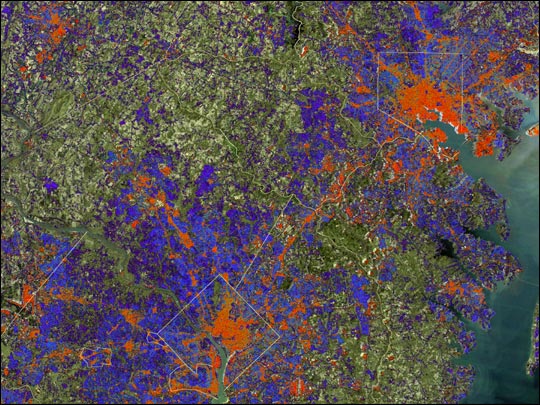


high resolution images:
map of impervious surfaces (4.2 MB)
true-color image (3.1 MB)
Scientists are using a major advance in satellite-based land surface mapping to create more accurate and detailed maps of our cities. These maps provide urban planners with a better understanding of city growth and how rainfall runoff over paved surfaces impact regional water quality.
These space-based maps of buildings and paved surfaces, such as roads and parking lots, which are impervious to water, can indicate where large amounts of storm water runs off. Concentrated runoff leads to erosion and elevated discharge of soil and chemicals into rivers, streams, and ground water.
Andrew Smith, a faculty research assistant at the Mid-Atlantic Regional Earth Science Applications Center produced a map of the Washington-Baltimore area that quantifies how much impervious surface there is across the entire region. Baltimore and the counties that border it have at least 20 percent, and up to 40 percent, impervious surface area, indicating that pollution from runoff could be a problem. The District of Columbia and surrounding watersheds in Virginia and Maryland have levels of impervious surfaces between 20 percent and 30 percent percent. Areas between and beyond the Baltimore-Washington corridor are more "green" with levels that range from 0 percent to 20 percent impervious surface areas.
The image above shows the extent of impervious surfaces in and around Washington and Baltimore. Red represents high concentrations of impervious surfaces. Blue represents moderate concentrations and green represents low concentrations of impervious surfaces. The base image was acquired by NASA's Landsat satellite, while the map of impervious surfaces was derived with data from both Landsat and Space Imaging's high-resolution IKONOS satellite.
For more information, read: New Satellite Maps Provide Planners Improved Urban Sprawl Insight
Image courtesy Stu Snodgrass, NASA GSFC Scientific Visualization Studio, based on data from Landsat 7 and IKONOS.